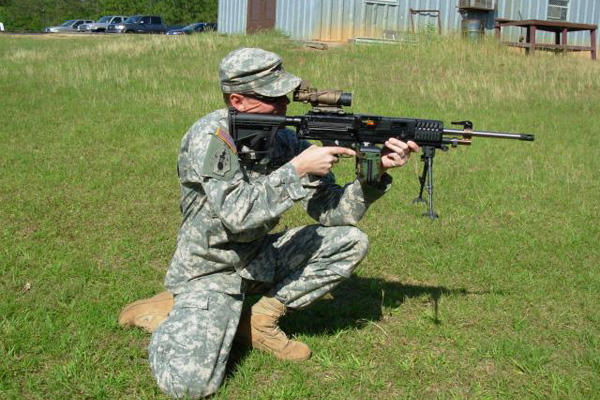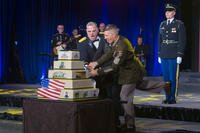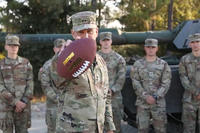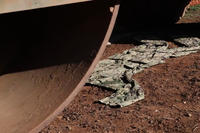Small arms used by American forces in the Revolution were many and varied, however at the beginning of the war the British Short Land Service Musket, often referred to as the Brown Bess, was perhaps the most common musket on hand. In 1777, the French allied themselves with the American cause and began sending arms and equipment.
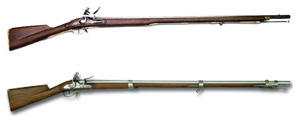
Early America 1786-1833
The U.S. Musket Model 1795, the principle small arm used by the Army in the War of 1812, was a copy of the caliber .69, French Model 1763 Infantry Musket. These muskets were made at the armories at both Springfield, Massachusetts, and Harper's Ferry, Virginia. The Model 1795 Muskets produced by Eli Whitney incorporate all of the latest technological features such as a rounded hammer face and slanted pan. Whitney delivered 10,000 muskets to the Army under a July 1812 contract. Muskets manufactured under this contract are marked "N. Haven" on the lock plate.
The U.S. Model 1816 Musket was similar to the Model 1795, but incorporated enough new features to be given a new designation. These muskets were made at the armories at both Springfield, Massachusetts, and Harper's Ferry, Virginia. This pattern of musket will continue in use until the Mexican War.
Mid-19th Century 1833-1850
The U.S. Model 1842 Musket was the first U.S. weapon made at both the Harpers Ferry and Springfield Armories with fully interchangeable parts. It was also the first regulation musket made in the percussion ignition system by the national armories and was the last of the smoothbore .69 caliber muskets. A total of 275,000 Model 1842s were produced between 1844 and 1855, 103,000 at Harper's Ferry and 172,000 at Springfield Armory.
The Caliber .54, Model 1841 Rifle was the first rifle made in the percussion ignition system at a national armory. Until the Mexican War it was only provided to militia rifle companies in various states. The Model 1841 was made by Harpers Ferry Armory from 1846 to1855 with a total produced of about 25,296 arms. The weapon has a 33" browned barrel, which was made without provision for attaching a bayonet. The walnut stock is distinguished by a large patch-box on right side of the butt. Sometimes called the "Mississippi Rifle," it owes this name to the successful use of the weapon by a Mississippi rifle regiment under the command of Jefferson Davis during the Mexican War.
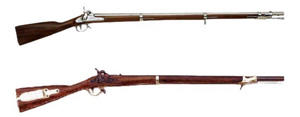
Mid-19th Century 1851-1872 In July 1855, Secretary of War Jefferson Davis authorized the production of a new .58 caliber rifle musket. This was the first rifled weapon produced for general issue by the U.S. Army. A rifle version was also produced to replace the M1841 Rifle. Both the rifle and the rifle-musket were equipped with the Maynard patented priming system which used a roll of caps in a compartment in the lock that advanced when the weapon was cocked.
The carbine was used by the Cavalry and numerous types were used during early part of the Civil War. Three carbines came to predominate by the middle of the war: the Sharps, which fired a .54 Caliber paper combustible cartridge or could be loaded with a bullet and loose powder; the Spencer, which was a magazine weapon that held seven rounds of .56 caliber metallic cartridge in a tube in the butt stock; and the Burnside, which used a unique tapered .54 Caliber metallic cartridge fired with a standard percussion cap. In all, more than 95,000 Sharps, 80,000 Spencer, and 54,000 Burnside Carbines were purchased.
Late-19th Century 1872-1902
The .45 caliber trapdoor rifle would remain in use with the Regular Army until 1894 and with the National Guard in various states until at least 1905. The version used the most, by both the Regular Army and the National Guard was the Model 1884 with the long range Buffington rear sights. As the supply of socket bayonets began to dwindle in the late 1880s, the last model of .45 caliber rifle to be produced, the Model 1888, had a ramrod bayonet.
The .45 caliber Model 1884 carbine was replace in 1896 with a .30 caliber carbine version of the Krag-Jorgensen, although the trapdoor would continue to be used by the National Guard into the early part of the 20th century. The Model 1896 Krag-Jorgensen carbine was used by the cavalry of the Regular Army and the majority of Volunteer cavalry units during the Spanish-American War. A small number of Model 1898 carbines were produced and issued during the war as well, and in 1899 a newer version of the Krag, known as the Model 1899 carbine would take the regular cavalry into the new century fighting insurgents in the Philippines.
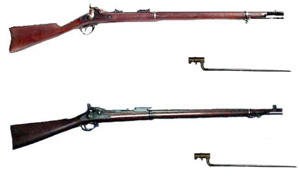
Mid-20th Century 1926-1956
The United States Rifle, Caliber .30, M1 (also known as the Garand Rifle in honor of its designer John Garand), was the first semi-automatic rifle in the world to be generally issued to infantry. The Army began looking for a replacement for the M1903 rifle almost immediately following the end of World War I. Research and development continued at Springfield Armory into the early 1930s with numerous problems being encountered. But on November 7, 1935 a new rifle was cleared for procurement and on January 9, 1936 became Army standard as the M1 rifle. However, production difficulties and design issues continued to plague the new rifle. Finally, with the redesign of the barrel and gas cylinder assembly in early 1940, the rifle was ready to go into full production. Output reached 600 rifles a day by January 1941, and by the end of the Army was equipped with the new rifle.
The M1 was a gas-operated, semi-automatic rifle that utilized an eight-round clip which gave United States forces a significant advantage in firepower and shot-to-shot response time over enemy infantrymen in battle. The weapon was the principle infantry weapon used in both World War II and Korea.
The Thompson submachine gun was designed by General John T. Thompson, who started the Auto-Ordnance Corporation in 1916 for the purpose of developing his new weapon. Originally designed for trench warfare the prototype submachine was produced too late for the war. In 1919 the weapon was officially named the "Thompson Submachine Gun" and it was the first weapon to be labeled and marketed as a "submachine gun."
The M3 submachine gun (known as the "Grease Gun"), entered Army service on December 12, 1942. The weapon was produced by the Guide Lamp Division of General Motors Corporation. Even at the development stage, the weapon's design focused on simplified production, employing metal stamping, pressing and welding. The M3 was an automatic-only blowback operated weapon that fired from an open bolt fed from a 30-round detachable box magazine. The weapon had a crank-type cocking mechanism on the right side, and a telescoping metal wire stock, which featured threads at both ends used to attach a bore brush, so that it could be used as a cleaning rod.
The Browning Automatic Rifle (commonly known as the BAR), was designed in 1917 by John M. Browning, as a replacement for French-made light automatic rifles. The BAR was a .30 caliber, gas-operated, select-fire, air-cooled, automatic rifle that fired from an open bolt fed from a 20-round detachable box magazine.
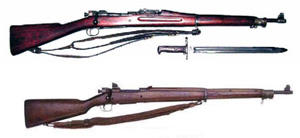
Late-20th, Early 21st Century 1954-2006
The M16 Rifle was the initial version first adopted in 1964 by the United States Air Force. It was a lightweight, 5.56 mm caliber, air-cooled, gas-operated, magazine rifle with a rotating bolt actuated by direct impingement gas operation. The weapon was constructed of steel with an aluminum alloy receiver and a composite plastic stock.
The M16 was ordered as a replacement for the M14 at the direction of Secretary of Defense Robert McNamara over the objection of the Army. The Army began to field the XM16E1, an M16 with a forward assist feature, in late 1965 with most going to Vietnam. When the XM16E1 reached Vietnam, reports of jamming and malfunctions in combat immediately began to surface. The XM16E1 was standardized as the M16A1 Rifle in 1967, and improvements to the rifle along with training in proper cleaning diminished many of the problems, but the rifle's reputation continued to suffer. Moreover, complaints about the inadequate penetration and stopping power of the 5.56mm cartridge persisted throughout the conflict.
The M16A2 entered service in the mid-1980s and fired a NATO standard Belgian-designed M855 or M856 5.56mm cartridge. The M16A2 was a select fire rifle capable of semi-automatic fire or three-round bursts. The burst-fire mechanism utilized a three-part automatic sear that fires up to three rounds for each pull of the trigger. The mechanism is non-resetting, which means that if the user fires a two-round burst and releases the trigger, the weapon will only fire a single round the next time he or she pulls the trigger. In theory, burst-fire mechanisms allow ammunition conservation for troops with limited training and combat experience. Other features included an adjustable rear-sight for wind and elevation, a slightly longer stock, heavier barrel, case deflector for left-handed shooters, and rounded hand guards.
A combination of the M16A4 and M4 Carbine continued to replace existing M16A2 Rifles used by the Army. The M16A4 incorporated a flattop receiver unit and a hand guard with four Picatinny rails for mounting optical sights, lasers, night vision devices, forward handgrips, removable carry handle, and flashlights. The M4 was a carbine version of the M16A1 with a small retractable stock and shorter barrel. The M4A1 was capable of fully automatic fire and was used as a submachine gun by selected individuals in situations such as house-to-house fighting.
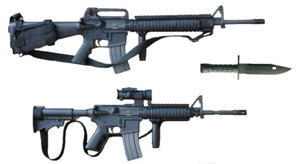
Between 2003 and 2006, soldiers reported a lack of stopping power with the 9mm ammunition, and problems with the magazines. Testing showed that the 9mm magazines failed due to the heavy phosphate finish called for in the government specification when used in the environmental conditions in Iraq. After corrections were made to the specifications, almost two million new magazines were distributed without any further malfunctions. The 5.56mm M249 Squad Automatic Weapon (SAW) was a fully-automatic, gas-operated, magazine or belt-fed weapon. It was used within the infantry squad as an automatic rifle, filling the void created by the retirement of the Browning automatic rifle in 1960, a role that both the M14 and M16A1 rifles had failed to fill. The M249 replaced the M16A1 rifles used in the automatic mode in the rifle squad on a one-for-one. The automatic rifleman supported the infantry squad by providing suppressive fire against point targets in the last 100 yards of the assault. The M249 was also be used as a light machinegun, when fired from a stable position and not required to conduct fire and maneuver with the squad. When used in the machine gun roll, the gun remained with the base-of-fire element.
The M79 was an attempt to increase firepower for the infantryman by using an explosive projectile more accurate and with further range than a rifle grenade, but more portable than a mortar. It was adopted by the Army on December 15, 1960 with the first deliveries received in late 1961. Owing to its ease of use, reliability, and firepower, the M79 almost immediately became popular with infantry soldiers. The M79 could consistently drop grenades into a 24 inch circle, 150 yards away.

